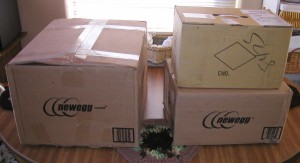I elected to give myself a little project this weekend and it started with this small mountain of boxes:
Don’t worry, there’s a method to my madness. It isn’t often my crazy ideas have a purpose, so this time I’m making an exception. I also promised to share some of my experiences with a friend of mine who was interested in the project so he could freeload some information share in the learning experience.
The idea started about two weeks ago when I was mulling over some way of providing my mother with an entertainment system that could replace a few aging devices. Since she’ll be having back surgery next week, I figured it would be much easier for her to contend with a single device than to muck about with several. Plus, she has an old video cassette recorder that is on the verge of going wherever it is electronics go when they pass on into the afterlife, and it occurred to me that bringing her kicking and screaming into the digital age might not be such a bad idea. She’s in desperate need for a video recorder of sorts and being as I inherited her frugal nature, I wasn’t about to purchase a TiVo unit for her. TiVos are too limited anyway. She needs a relatively decent computer to sub-in for the period of time she won’t be able to sit at an actual desk. Plus, with her “real” computer being in an upstairs room and her refusal to let us bring it downstairs, I started mulling over a solution.
So far, I’m fairly impressed. There have been some teething problems–the project is still a work-in-progress–hence I’ll be posting this DIY walk-through in multiple parts.
Read more…
My old SoundBlaster Live! was finally starting to show its age. I’m not sure whether it was a driver issue or hardware, but whenever I’d start up something with environmental audio (particularly games), I’d hear nothing but static–and maybe some of the game’s audio mixed in with it. Now, the unusual thing is that it would occasionally sound like a driver issue; there’d be a single sound, like the clicking of a menu button, that would repeat over and over again as if the system were playing whatever happened to be caught in the output buffer. Sometimes, it would genuinely try to do something, and you could hear whatever sounds were actually taking place–except that they were mixed in with awful static. While I once tried to uninstall/reinstall the SB Live! drivers, I couldn’t get this particular issue to go away this time around (it worked once before I re-imaged my system). Heck, not even reducing “hardware acceleration” would work. Not that I expect that setting really does a whole lot in the first place. Maybe it’s there to make people like me feel better that we have a slider to tweak. At least I have /proc and /dev in Linux to examine if something doesn’t work quite right…
So, I finally broke down and got myself an HT|Omega Striker. It’s a really impressive card that most certainly lives up to its expectations. Read more…
I recently acquired a Thermaltake USB 2.0/eSATA External Drive Enclosure and it compares favorably to the previous one I put together.
Assembly of this unit is fairly straightforward but there are a couple of non-obvious snags that some of the product reviews didn’t cover. However, you have me to give you another step-by-step guide. Read more…



